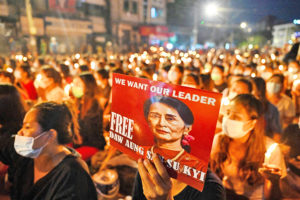ASEANEWS-CIVIL WAR | MYANMAR: Opinion | The evolution of warfare in Myanmar
Members of Myanmar’s armed forces take part in joint military exercises in February 2018 (EPA)
.
.
.



FREE ASEAN –
FREE MYANMAR/CAMBODIA/THAILAND /LAOS
FREE Aung San Suu Kyi
.

Nearly four years of post-coup conflict have transformed the way Myanmar’s military and its many enemies wage war against each other
.

One year after the launch of Operation 1027 and the escalation of armed conflict throughout Myanmar, and nearing four years of repressive rule by the State Administration Council (SAC), how much has the nature of warfare changed in Myanmar?
The answer is—dramatically and in multiple ways, and for varied reasons. There has been military adaptation and innovation in all three branches of the Myanmar armed forces—the army, air force, and navy—and by ethnic armed organisations (EAOs) and other resistance forces under the general title of People’s Defence Forces (PDFs), in ways that have transformed the shape of fighting.
In some ways, the past three years of conflict represent a form of revolution in military affairs for EAOs, which have dramatically adapted their doctrine and technological capacity, and has seen the Sit Tat, or Myanmar military, fight an almost total war for survival.
Understanding these changes in the nature of warfare is essential for analysts and the media, but also for efforts to understand the security sector and to start planning ahead for deconfliction, future peace agreements, and for human rights and accountability documentation when the timing is right.
The challenges of understanding these changes are daunting, especially as the conflict is ongoing and being waged in multiple locations and extremely complex situations. There needs to be more attention on aspects of the conflict that have a major impact on the course of the revolution and how they impact the civilian population. There are two broad and interlinked phenomena that are useful to understand the evolution of warfare since 2021 and track the trends of change amongst multiple armed actors.
.Ads by:
Convergence of Guerrilla and Conventional Warfare
For most of Myanmar’s civil war since the 1950s, guerrilla warfare was mostly the norm across the country: small unit tactics, hit-and-run ambushes, sabotage of infrastructure, occasional storming of isolated hilltop bases. However, there were also periods of semi-conventional warfare when insurgents defended major base areas and the Sit Tat would assault them with divisional sized units: it was a major factor in the creation of the Light Infantry Divisions in the 1960s.
Offensives against Communist base areas in the Bago Yoma or northern Shan State, or against Karen National Union (KNU) bases along the Thailand-Myanmar border, were large-scale operations but brutally low-technology events, an infantry war with light artillery back up and often thousands of civilian porters to carry supplies. So much of the conflict was in isolated hill and jungle country, where domination of the highest summit determined advantage and supply lines.
The early days of the 2021 revolution followed this model, with hit-and-run ambushes in the Dry Zone, and EAOs and their new PDF allies striking at isolated bases. Yet this began to change in late-2022, and most dramatically when Operation 1027 was launched in late 2023, the most daring coup de main in Myanmar insurgent history. The Brotherhood Alliance, comprising the Myanmar National Democratic Alliance Army (MNDAA), Arakan Army (AA) and the Ta’ang National Liberation Army (TNLA), and their constellation of alliances, have been at the forefront of this evolution.
Increasingly the conflict in northern Shan, Kachin, Karen (Kayin), and Rakhine states are transitioning from classic insurgency to either greater conventional warfare or a hybrid of unconventional war and conventional operations. What does this mean? In Myanmar’s reality, it could be seen as both symbolic and tactical: conventional wars are usually cast as two nation states in open hostilities with each other. The SAC’s multiple protagonists are seeking forms of new political arrangements that could be seen as inter-state competition within Myanmar.
This new hybridity of warfare is also strongly evident in the use of tactics, where EAOs mass main force troops and seize large patches of territory, including urban areas such as Lashio, Mogok, and many more. The fighting in Rakhine has been largely conventional, as the AA has methodically advanced on regime-controlled territory and painstakingly cleared enemy forces out of the area, from the capture of the Hnone Bu tactical base in Paletwa in late 2023 and the Mee Wa firebase several weeks later, to the fall of the Maung Shwe Lay navy base in September, often after prolonged sieges and a combination of infantry assaults and increasing use of drone strikes and artillery.
.

So, too, the Sit Tat, which is operating almost completely as a conventional force in its multiple areas of operations, using its advantage as a largely conventionally configured military that has waged mostly punitive counter-insurgency operations in the past. An order of battle largely designed to repulse outside invaders is now being used against multiple domestic opponents, as it has been for decades. An in-depth study of the Myanmar military’s counter-insurgency approaches would likely conclude it violated almost all central tenets of fighting insurgencies, and was a hybrid of conventional warfare, pacification, and wanton cruelty.
Many insurgencies also mixed insurgent hit-and-run tactics with aspects of conventional operations: most revolutionary forces in Myanmar over decades were all “seeing like a state” and many have been configured along conventional military lines, often with lineages from British and American forces, or the strong influence of the Chinese Communist Party in Kokang and Wa areas, and through the Communist Party of Burma.
In past periods of the civil war in which operating space was fluid, the military defined white (central authority controlled), brown (contested space), and black (insurgent controlled) areas, common to many counter-insurgency conflicts. However, since Operation 1027, some semblance of a “frontline” in many spaces has formed, especially in northern Shan State and since Mogok fell to the TNLA, in response to which multiple attempts at Sit Tat counter-offensives have been mounted to take back lost territory. Many fighting areas throughout Rakhine State have also been forms of frontlines, as the AA methodically besieges military base areas and then overruns civilian towns.
The Myanmar Peace Monitor has mapped some 80 towns that have fallen to resistance forces, most of them since Operation 1027. This marks an unprecedented shift to urban warfare utterly unique in seven decades of civil war. Insurgents don’t go into towns unless they can hold them, which by and large has transpired. The major challenge will be defending them, administering them, and then governing. That is a clear indication of the shift into conventional warfare.
.Ads by:
Heavy Firepower and Combined Arms
One major development that illustrates the still asymmetric nature of the conflict is the Sit Tat’s combined arms approach to operations, especially in the use of heavy firepower. Combined arms can be described as “indirect and direct fire to support ground maneuver and [close] with the enemy.” In multiple battlescapes across Myanmar, the military is utilising heavy firepower from airstrikes and increasingly drone strikes, artillery, and by naval forces.
Airstrikes have received, rightly, a great deal of attention, especially because of their dramatic surge following Operation 1027. Nyan Lynn Thit Analytica has calculated that from May to August 2024, there were 820 airstrikes resulting in 455 civilians killed and 819 injured. Compare this to 2021, when airstrikes were employed much less but have gradually risen, with destructive effects on the civilian population and slowing down, but not stopping, resistance advances.
Air power began to be more dramatically used during the resumption of the war against the Kachin Independence Organisation (KIO) in 2011, and then the several years of spreading armed conflict in northern Shan State and Arakan State when it was largely Mi-35 helicopter gunships used. The deployment of air power now is by multiple jet fighter-bombers with, at times, fuel air explosives and precision-guided munitions, used across the country. This is a mixture of low- and high-tech bombing, including using the slow-moving twin-propeller light transport Y-12 aircraft to drop mortar rounds out of windows.
The deployment of drones, or unmanned aerial vehicles (UAVs), by almost all armed groups in Myanmar has arguably been the most dramatic element of the revolution in military affairs since the coup. Widely used by ground troops as surveillance systems before 2021, UAVs have rapidly entered the order of battle of the Sit Tat for surveillance and target acquisition for artillery, target correction capability to make fire support more accurate, and increasingly, for delivering large payloads via weaponised UAVs.
Chinese-made drones such as the Sky O2A, CH3A, and the Yellow Cat A2 are now all in service, as is the Russian Orlan 10E, and large Chinese-made agricultural quadcopter drones that have bedevilled many EAOs during 2024 with accurate and high-temp attacks. In intensifying attacks against resistance forces in Tanintharyi Region, the Sit Tat has been deploying high numbers of UAVs to attack ahead of ground assaults. On October 22, the SAC used drones in its first ever attack on the headquarters of the KNU in Brigade 7, without inflicting any casualties.
.
 Resistance forces attach explosives made out of plastic pipes to a medium-sized drone (Federal Wings)
Resistance forces attach explosives made out of plastic pipes to a medium-sized drone (Federal Wings)
.
.
EAOs have also made greater use of drones, seen most dramatically in the fighting to take Lashio in late July and early August. The MNDAA used hundreds of drone strikes. PDFs are making significant headway in their use of drones, utilising their technically proficient members to manufacture craft UAVs, including 3D printer wingspans, and convert smaller drones to carry mortar rounds. In several cases, Sit Tat or Myanmar Police Force bases have been almost completely destroyed by drone strikes on security personnel who refused to surrender. While the drone competition has been intensive and fast paced, the SAC’s superior access to Chinese, Russian, and potentially Iranian technology suggest an important asymmetry to consider. Nevertheless, the EAO and PDF innovation in this field could be an important counterpoint to the junta’s air power and artillery.
Artillery is often overlooked in conflict analysis, but has been essential for Sit Tat operations for many years, especially since its Artillery Command was significantly expanded in the 1990s, although Russian-supplied equipment seems to be more efficient than the Chinese-supplied pieces. Firebases are crucial for integrated territorial control across Myanmar, by directing artillery fire at approaching insurgents, targeting, or protecting, road transport, to protect infantry columns with “creeping fire” (marching barrages of fire ahead of manoeuvring troops), and in areas throughout Myanmar to terrorise civilians with random attacks. Methodically targeting these firebases is a little known but crucial element of resistance forces’ strategies to consolidate their occupation of liberated areas.
This can be seen in three concurrent battles over the past several months involving different resistance forces besieging and eventually taking control of major hilltop bases. One is the TNLA’s fight for control of Tawng Hkam, a village in Shan State’s Nawnghkio Township that hosts the regime’s Artillery Operations Command 902. Another is the battle for the Mae Taung strategic hilltop artillery base, which the AA had to capture on October 7 before it could march on the Western Regional Military Command headquarters in Rakhine State’s Ann Township. (The AA has reportedly used captured heavy artillery as part of its ongoing siege of the town of Ann, but this has yet to be confirmed.) And the third is the Karen National Liberation Army’s attacks on the Swe Taw Kone firebase south of Myawaddy, which was overrun two weeks ago after a siege of several months.
In years past, it was exceedingly rare for EAOs to attempt to overrun heavily defended firebases, although the AA made a huge effort in early 2020 to take the Mee Wa base in Paletwa; that effort failed, with heavy casualties inflicted, but was repeated, this time successfully, in late 2023. Recent mapping by the Center for Arakan Studies shows in detail the number of military and Border Guard Police (BGP) camps in each of the 10 townships the AA has overrun since November 2023. Paletwa, including the Mee Wa Tactical Operations Command that fell in early 2024, had 10 installations, while Maungdaw had 25 and Buthidaung 18. These are all major military undertakings by an army with an estimated troop strength of around 40,000 soldiers.
The EAOs have long faced a disadvantage with heavy firepower. The Brotherhood Alliance and other resistance forces have used unguided 107mm Type 63 ground-to-ground rockets for several years, even bombing Pyin U Lwin and Lashio in 2019. AA footage of fighting around Maungdaw in recent months shows fighters using a range of rocket-propelled grenades and the venerable 75mm recoilless rifle, a mainstay of Myanmar insurgent forces for decades.
One ongoing development could be the revolution’s use of heavier artillery, having seized multiple weapons systems from the firebases overrun over the past year. These appear to include the Russian-supplied D-30 122mm howitzer (Moscow delivered some 500 pieces 20 years ago) which has a range of 15-20km, or the heavier M-46 130mm field gun, and several variants of truck mounted Multiple Launch Rocket Systems. The military manufactures most of its own ammunition for these pieces, large stockpiles of which are now in resistance armouries. The EAOs and PDFs have also captured multiple 81, 82 and 120mm mortars, as evidenced by their ample “show and tell” after-action displays of equipment and ammunition.
The challenge is how do revolutionary forces repurpose them all without adequate training? Captured Sit Tat troops could well be employed to instruct EAOs on their use, willingly or under duress, but it’s not clear how much of the equipment has been disabled or is still operative. But this also suggests a significant reworking of insurgent doctrine if captured conventional weapons systems are incorporated into operations. However, if many EAOs wish to hold onto captured territory, a transition to conventional defence using heavier firepower is a major element of that change.
.

KIA and allied resistance forces examine artillery captured at a junta base in Kachin State in March (NUG)
.
The junta’s navy has also been involved in fire support operations across Myanmar in unprecedented volume since the coup, along the Chindwin, Ayeyarwady, Salween and Kaladan rivers and along the Rakhine coast. In late March, the navy bombarded Dhamma Tha, a village on the Gyaing River in Mon State’s Kyaikmaraw Township, destroying 400 civilian homes. By some local reports, the navy is operating over 30 vessels along the coasts and rivers of Rakhine State, many of which have been engaged in support bombardments for Sit Tat operations and punishment attacks on towns that have fallen to the AA. Yet the AA has been remarkably adept at targeting naval ships, sinking several in early 2023 as the rout of the Sit Tat gathered pace and soldiers and their families fled the area by boat.
River resupply convoys from Mandalay to Bhamo on the upper reaches of the Ayeyarwady River have been targeted: most vessels are festooned with rubber car tires for added protection. Navy boats have also been used as direct fire support for ground troops retaking villages along the river. Similar to airstrikes, naval operations are remarkable not because of their use, but the relatively high operational tempo in multiple locations on a daily basis. Yet as seen in Rakhine, these combined arms operations have not blunted more conventional forces attacks: they have inflicted massive punishment, but are not sufficient to fully deter EAO advances.
.
Ads by:
The Dry Zone Disorder
One part of Myanmar where the shift to hybrid warfare is not evident is in the Anya Dry Zone of Sagaing Region, and in the conflict zones of Magway and Mandalay regions. These areas have hundreds of armed actors, PDFs and other permutations, with some level of EAO involvement—KIO forces in the north and the AA assisting some groups in Magway. Large parts of the Dry Zone are a violent anarchy, with increasing reports of abuses by revolutionary forces against civilians, and infighting between armed groups. The patterns of resistance are still mostly hit-and-run attacks on road convoys, ambushing Sit Tat patrols, police stations, and some smaller military installations. Airstrikes and artillery fire on civilians and insurgents alike are intensive, and a clear tactic of war. The burning of some 90,000 homes throughout Myanmar has been particularly intensive in Sagaing, which has borne the brunt of the domicide committed by the junta’s forces.
An industry of speculative analysis has emerged of Western nongovernmental organisations funding research that counts PDFs in the Dry Zone and seeks to track relations and leadership patterns: a pointless exercise that produces little insight and provides no real understanding of how patterns of conflict have changed, probably because the Dry Zone is stuck in a pattern of violence that has transcended revolution and transitioned to retribution and vengeance between communities. The National Unity Government (NUG) has claimed progress in its local administration in Anya, but the security aspects of these efforts have contributed to the chaos, creating an overly bureaucratised system and far too many armed actors with elaborate reporting lines. The currently fashionable approach to “bottom up federalism” is not working in the Dry Zone, and the NUG looks incapable of establishing order, let alone fostering a vision of what a post-SAC security landscape might look like.
Yet there could be grounds for optimism in the Dry Zone, where recent developments suggest the possibility of reducing inter-group conflict, creating more productive alliances, and making the transition to conventional operations. The All Burma Students Democratic Front has slowly but steadily expanded in the region, recruiting and training new soldiers and fostering better cooperation between different PDFs. The Bamar People’s Liberation Army has also announced recently that hundreds of its troops will be redeployed to Sagaing Region from northern Shan State. Both of these groups could potentially inject a measure of discipline and professionalism into the disordered conflict landscape. But the disorder in Anya runs deep, and this lack of cohesion and cooperation only serves to support the Sit Tat’s brutal blend of pacification and punishment.
Yet in so many other parts of Myanmar, the Sit Tat and EAOs are locked into an increasingly destructive conventional conflict that has been transformed by nearly four years of fighting. Two elements stand out: the institutional survival of the Myanmar armed forces through heavy firepower, and the resolve of many EAOs to continue their offensives to end SAC rule. The intensity of the conflict and the SAC’s commitment to high-order violence to survive will likely intensify as the regime continues to lose ground.
David Scott Mathieson is an independent analyst working on conflict, humanitarian, and human rights issues in Myanmar
.
 Ads by:
Ads by:

@[email protected]


 Memento Maxima Digital Marketing
Memento Maxima Digital Marketing









